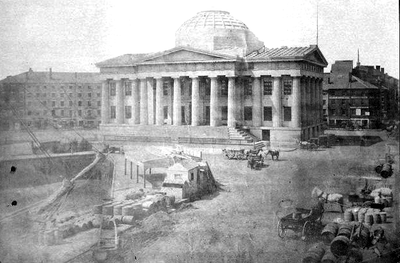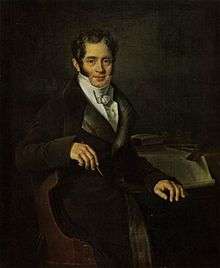1849 in architecture
The year 1849 in architecture involved some significant events.
| |||
|---|---|---|---|
|
Buildings and structures
|
Buildings and structures
Buildings
- March 1 – Ashby railway station, Leicestershire, England, probably designed by Robert Chaplin, opened.[1]
- May 1 – Stone railway station, Staffordshire, England, designed by H. A. Hunt, opened.
- September 2 – Gare de l'Est railway station in Paris (France), designed by François Duquesnay, opened.
- October 30 – London Coal Exchange opened.
- December 1 – Gothenburg City Hall (Sweden), designed by Pehr Johan Ekman, opened.
- Church of the Immaculate Conception, Farm Street, central London, designed by Joseph John Scoles, completed.
- All Saints, Ennismore Gardens, south London, designed by Lewis Vulliamy, interior completed.
- Boston Custom House (Massachusetts), designed by Ammi B. Young, completed.
- Rich-Twinn Octagon House, Akron, New York, built.
Events
- March – The Journal of Design and Manufactures is established by Henry Cole.
- May – The Seven Lamps of Architecture by John Ruskin is published.
Awards
- RIBA Royal Gold Medal – Luigi Canina.
- Grand Prix de Rome, architecture – Denis Lebouteux.
Births
- January 9 – Gaetano Koch, Italian architect (died 1910)
- February 22 – Carl Holzmann, Austrian architect (died 1914)
- May 22 – Aston Webb, English architect (died 1930)
- August 29 – John Sulman, English-born Australian architect (died 1934)
Deaths
- April 18 – Carlo Rossi, Neapolitan-born architect working in Saint Petersburg (born 1775)
- September – Daniel Robertson, American-born architect and garden designer working in Oxford and Ireland (born c. 1770)
- Robert Cary Long, Jr., American architect working in Baltimore (born 1810)
- John Pinch the younger, English architect working in Bath (born 1796)
gollark: Idea: what if inodes, but they're arbitrarily long strings and also just the path?
gollark: I don't sanitize it everywhere, but it also doesn't have perms so it's fine.
gollark: ++choose 1000 <@319753218592866315> <@!258639553357676545>
gollark: ++choose 1000 "ferris good" "C good"
gollark: ++choose 1000 "gollark bad" "lyric bad"
References
- Biddle, Gordon (2003). Britain's Historic Railway Buildings: an Oxford Gazetteer of Structures and Sites. Oxford University Press. ISBN 0-19-866247-5.
This article is issued from Wikipedia. The text is licensed under Creative Commons - Attribution - Sharealike. Additional terms may apply for the media files.

